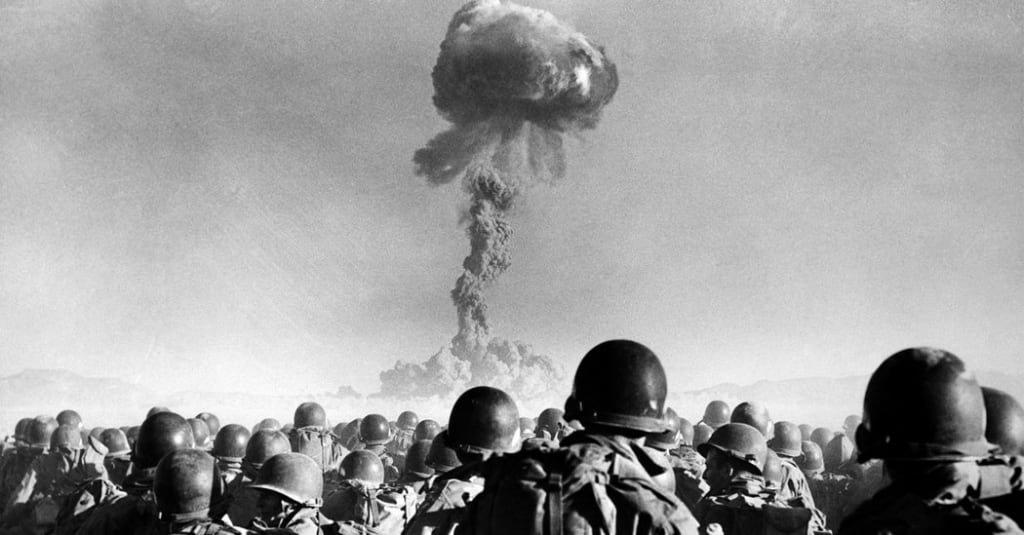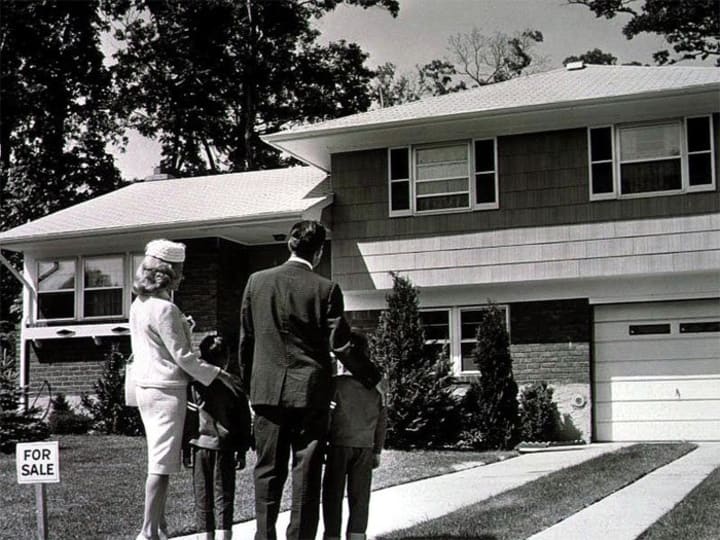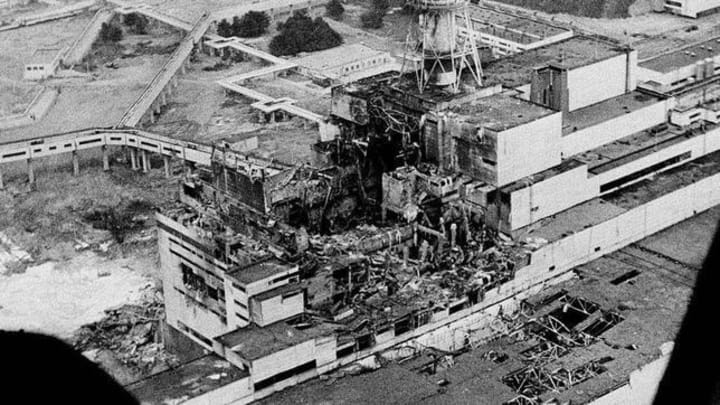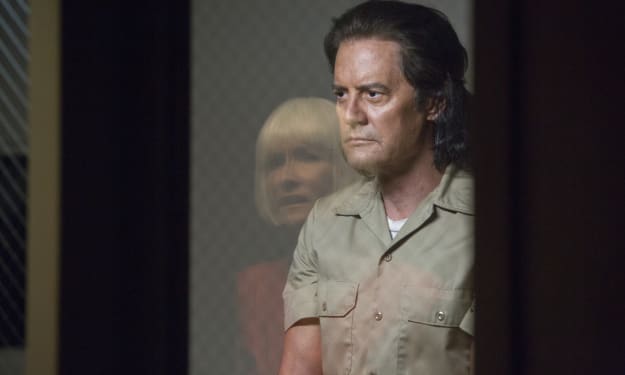Twin Peaks 2017: The Birth of an American Nightmare
Lynch & Frost take us to ground zero of the horrors that define Twin Peaks' America.

"It was a fantastic decade in a lot of ways ... there was something in the air that is not there any more at all...It was a really hopeful time... You got the feeling you could do anything. The future was bright. Little did we know we were for a disastrous future."
David Lynch, Lynch on Lynch, 2005
The start of the Atomic Age, which began in 1945 in the desert of New Mexico with the first test of a plutonium bomb, marked a significant moment of hope and inspiration in the USA. Not only did the tests lead to America's deployment of nuclear weapons that changed the course to victory in WWII, but spurred a wave of scientific speculation that atomic energy would revolutionise every aspect of American life. It's apparently limitless energy potential compared to oil and gas meant everything from cars to household appliances would be nuclear powered, rendering fossil fuels obsolete with years, and that nuclear power stations would produce electricity so plentiful and cheap that there wouldn't even be a need to meter it. Radiation could potentially be used to help preserve food, and have applications in medicine, in the diagnosis and treatment of diseases. The 'splitting of the atom' and the imagery of atomic structure inspired a generation of designers to create furniture, fashion and buildings that resonated positive futurism. Following the Great Depression and WWII, America needed an optimistic means to redefine it's way of life, and Atomic Energy was to be the torch-light of the new America Dream.
"My childhood was elegant homes, tree-lined streets... blue skies, picket fences, green grass, cherry trees. Middle America as it's supposed to be. But on the cherry tree there's this pitch oozing out – some black, some yellow, and millions of red ants crawling all over it. I discovered that if one looks a little closer at this beautiful world, there are always red ants underneath."
David Lynch, Lynch on Lynch, 2005
This idealism is epitomised in the vision of 1950's American suburbia, and the pursuit of a perfect middle-class 'Nuclear Family'. A period of substantial economic growth, buoyed by domestic automobile and manufacturing industries, increased employment and wealth among the average American, and the commercial advertising world, hugely assisted by the boom in TV set sales, sold the public a new family paradigm; a working dad, home-making mom, 2.4 children, and a shiny new Ford in the drive of a detached house full of modern conveniences, in a pastel suburb of white picket fences and perfectly manicured lawns. Elegantly simple, deeply romanticised yet ostensibly attainable, it was the aspirational drive that would be the zeitgeist of the 1950's.

The 1950's suburban American ideal
Both Mark Frost (born Nov. 25th, 1953) and David Lynch (born Jan. 26th, 1946) are children of the 1950's, and while they have expressed their warm nostalgia for the era, in interviews and their work, it seems that they've both continued to be influenced by the Atomic Dream into adulthood, as the façade was pulled back and the terrible nature of its legacy became steadily apparent. The possibility of radiation causing cancer was proposed as early as 1902, but it was the ground-breaking work of geneticist Hermann Joseph Muller, published in 1927, that proved a link between increased radiation exposure and lethal mutations in model organisms; the highly publicised case of the Radium Girls in 1928, female factory workers who sued the United States Radium Corporation for damages after many contracted oral cancer from exposure via radium paint, put the health risks of radiation in the public consciousness, concern over which would increase exponentially in the wake of the bombings of Hiroshima & Nagasaki in 1945. H J Muller was awarded the Nobel Prize for Physics or Medicine in 1946, for 'the discovery that mutations can be induced by x-rays', and thanks in part to his public efforts, the earliest seeds of a civil anti-nuclear movement were sown.
Tensions rising throughout the 50's between the USA and Soviet Russia due to the proliferation and deployment of nuclear weapons reached boiling point in 1962 when, in response to America's failed invasions of Cuba and later installation of ballistic missiles in Italy & Turkey, Russia secretly negotiated with Castro to build missile launch facilities in Cuba, with America's subsequent discovery and attempted military block leading to the Cuban Missile Crisis.
"It shall be the policy of this nation to regard any nuclear missile launched from Cuba against any nation in the Western Hemisphere as an attack by the Soviet Union on the United States, requiring a full retaliatory response upon the Soviet Union".
President Kennedy, televised public address, Oct 22nd 1962
An unbearably tense week of negotiations saw the world fragmented, China openly siding with Russia/Cuba and the major European nations supporting USA's position; civilisation had never teetered so perilously close to the brink of full-scale nuclear war, and total atomic annihilation. Thanks largely to the efforts of President Kennedy and Communist Party leader Nikita Khrushchev, the crisis was resolved peacefully, but the message to the general populous was clear; thanks to America's creation of the Atomic Bomb, the rules of war had changed and anything on a World Wide scale now had only one plausible end - the total destruction of mankind. While created and used as a key component in bringing about the end of WWII, the lust and greed for nuclear military power had turned it into a Sword of Damacles hanging over the heads of humanity. The Cold War began here in earnest and 40 years of traumatic proxy wars would follow, having a far-reaching impact on social & political moods and economic stability, in the USA, Russia and worldwide.
“If man could apply half the ingenuity he’s exhibited in the creation of weapons to more sensible ends, there’s no limit to what he might yet accomplish.”
Mark Frost, The List of Seven
In 1962, in the wake of Cuba and growing public concern, the US government initiated Operation Plowshare, a project designed to test the use of nuclear explosions for construction and other non-aggressive means, in an attempt to show that there was more potential to atomic weapons that pure destruction; but the outcry over the environmental impact, including irradiating water sources, or drying them up altogether, fallout deposits in the atmosphere and possible seismic activity, and much resistance from Congress due to the economic sustainability meant it got off to a poor start. Despite some interesting geological discoveries, disappointing results yielded from natural gas stimulation testing (the gas was too irradiated to use) and ever increasing public opposition led to the project's cancellation in 1977.
The nuclear power industry started a rapid decline in the 70's too; early optimism about it cost effectiveness was dashed when it became apparent some nuclear electricity production was up to 10 times more expensive than established coal-fired power stations. The Atomic Energy Commission had predicted that one thousand nuclear power plants would account for all electricity production by the turn of the 21st Century, but as energy demand fell and building & maintenance costs rose, industry growth slowed considerably; the Three Mile Island incident in 1979 and the Chernobyl disaster in 1986 were essentially the final nails in the coffin, putting public fear and opposition at an all time high, and hobbling the industry for decades, it's reputation never fully recovering; the Atomic Dream was effectively dead & buried.

Helicopter view of the destruction caused by the Chernobyl disaster
When scientists first split the Atom, a God-like act of breaking down the very matter the physical world is built from, they unleashed a demon they could not hope to fully comprehend, let alone contain or control. Seeing only it's potential for producing energy, and how that energy could be weaponised to dominate their enemies, American politicians, military leaders and scientists bullishly seized on the transformative possibilities, before knowing or attempting to understand what the consequences for humanity may be. They sold this evil to the public by taking advantage of the broken down mood of a nation hit hard by The Depression and two World Wars, wrapping it up in a Dream of a new way of life, a future where there would be unlimited power, money and opportunities for all.
"The evil that men do lives after them."
Mark Anthony, Act III of Julius Caesar, by William Shakespeare
But the Dream turned into the most unimaginable Nightmare. Instead of being the ultimate means of defence and protection, the Nuclear Arms Race drove the world to the brink of destruction, instilling a deep seated fear and distrust in policy makers that would inform the social-political mood for generation. The nuclear power industry proved hugely expensive and fraught with disaster, it's by-products poisoning the land, air and water, permanently altering the environment, and causing sickness and disease in people. Trinity, the code name for the first test of an atomic bomb, proved to be America's definitive Pandora's Box moment; the evils within, unleashed with such fury, could never be contained, but maybe, just maybe some hope remained.
"Poisons! Deadly poisons! That's what's there. And what's waiting for you? Cancer! Leukemia! Auto-immune disorders! Pulmonary embolism! Warts! Psoriasis! Eczema! Cardiac arrest! Where are the cops when we need them? Anorexia, body image bullshit, microbial toxins, bacterial toxins, environmental toxins! Our air, our water, our earth! The very soil itself. Our food! Our bodies poisoned! Poisoned!"
Dr Laurence Jacoby a.k.a Dr Amp, Part 5 - Twin Peaks: The Return
This thematic influence is at the heart of Part 8 of Twin Peaks, seen in both literal and symbolic representation. The flashback sequence to the Trinity nuclear test deliberately affirms the specific date, day and time - there's no question that this is the point the dream & the nightmare began. As the bomb detonates, a long zooming sequence through the flames shows scenes of static information crackling, of molecular structure pulling apart and reforming, of space and time expanding and contracting - a fundamental change on every layer of reality. At the heart of the fire, a gas station convenience store (a warped distortion of iconic Americana) flashes and sputters as demonic sprites scuttle about it; inside the 'mother of abominations', an unholy entity surely representing what an affront to God this act is, spews forth a stream of filth into our world, in which can be seen the face of BOB, the embodiment of the evil that men do. We later see it's toxic result, the mutating affect of radiation made flesh in the abhorrent frog/insect hybrid that comes to life in the scorched landscape of the desert, and then crawls inside a young girl, likely changing her inside too. A new insidious horror has entered our lives and it's objective is clear - "Drink full, and descend."
“When this kind of fire starts, it is very hard to put out. The tender boughs of innocence burn first, and the wind rises, and then all goodness is in jeopardy.”
The Log Lady, Twin Peaks: Fire Walk With Me
The White Lodge denizens, themselves weavers of illusions and dreams, see what it happening and respond as they see appropriate. They create an orb of golden light, the face of Laura Palmer seen within, and send it into the world as a beacon of hope; the image is notably of Laura as Homecoming Queen, a evocative depiction of innocence and American wholesomeness. When we first entered Twin Peaks in 1990 Laura's death, as a victim of unspeakable torment in her own suburban home, the place American's were assured would provide the most comfort and safety, is the crux point to unearthing the horror's that lay beneath the romanticised surface of small town life. So much was revealed in it's wake - the corruption of corporate town benefactors like Ben Horne, selling young girl's futures down the river for profit and self-gratification; the veneer of the suburban middle class stripped back to reveal emotional and mental anguish in almost every home; the sad truth that many people came to understand how much danger Laura was in, yet stood by and did nothing. If the original series of Twin Peaks was a microcosm of America, then Laura's death was it's Atomic Bomb test.
"What kind of world are we living in where people can behave like this? Treat other people this way without any compassion or feeling for their suffering? We are living in a dark, dark age..."
Janey-E, Part 6 - Twin Peaks: The Return
Twenty-five years later and the world is darker and more despondent than ever: the younger generation, as seen in the likes Chad and Steve, are incredulous, yet as self-destructive as always; there's more physical sickness, more financial exploitation, and a deeper melancholy among the older characters; and the idyll of American suburbia is abandoned, a cold and empty vision, shown in the deserted ghost neighbourhood of Rancho Rosa. During a time like now, the world could use a ray of hope more than ever.
Twin Peaks themes of duality, balance and cycles are core to it's make-up; Part 8's subject matter could then well be telling. Lynch and Frost have just shown us the beginning of nightmare that was presented as a false dream; now maybe it's time for that nightmare to end, for the hope to become manifest, and the dream to come true.
About the Creator
James Giles
Writer, confessed geek and pop culture enthusiast, loves film, TV and video games. Blogged and written for various websites on all the above.






Comments
There are no comments for this story
Be the first to respond and start the conversation.